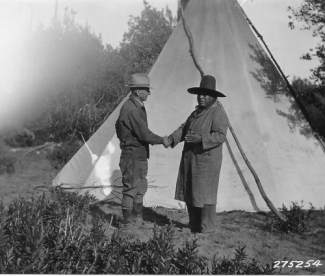Tribal Relations

Lands administered by the Gifford Pinchot National Forest have been home to indigenous people since time immemorial. Tribes with historic ties to the area include the Mishalpam, Táytnapam, Sλpúlmx (Cowlitz); Cathlamet, Multnomah, Cascades, Wasco, Wishram, Xwáłxwaypam (Klikitat), Wayám, Skínpah, Q’miłpah, and Yakama. Most descendants are today citizens of several federally-recognized Tribes, including the Cowlitz Indian Tribe, Confederated Tribes and Bands of the Yakama Nation, Nisqually Indian Community, and the Confederated Tribes of the Warm Springs Reservation. Citizens of the Chinook Indian Nation continue their efforts to secure federal recognition.
Federally Recognized Tribes & Treaty Rights
Under federal law, the U.S. Forest Service has a trust responsibility to honor the treaty rights of federally-recognized Tribes. Treaties are agreements between nations. Article VI of the Constitution affirms that treaties made under the authority of the government form a part of “the supreme Law of the Land.” In 1854-1855, Isaac I. Stevens, first governor and Superintendent of Indian Affairs of the Washington Territory, was tasked with liquidating Indian title to the land. Treaties were then the primary instrument of American Indian policy, establishing a formal relationship between the United States and individual Tribes, one that remains important and equally valid today.
Lands ceded under the Treaty with the Yakama in 1855 (for the Confederated Tribes and Bands of the Yakama Nation) and the Treaty of Medicine Creek in 1854 (for the Nisqually, Puyallup, Squaxin Island, and Steilacoom Tribes) include portions of the Gifford Pinchot National Forest. Both of these treaties include provisions that ensure reserved rights on ceded lands. These include: “the right of taking fish at all usual and accustomed places, in common with the citizens of the Territory, and of erecting temporary buildings for curing them: together with the privilege of hunting, and gathering roots and berries… upon open and unclaimed lands.” Isaac Stevens’ treaty with the Cowlitz, drafted in 1855, was never signed or ratified, their title to the land extinguished in 1864.
The Cowlitz Indian Tribe never signed a treaty or ceded their lands, and the Tribe was eventually unrecognized by the federal government and their lands were ultimately settled. In 2000, the Cowlitz Indian Tribe was finally recognized as a sovereign people by the federal government.
The Gifford Pinchot National Forest maintains a government-to-government relationship with the leadership of the federally recognized Tribes, consulting on a regular basis regarding issues that relate to the management of National Forest lands. In 1997, the Forest Service entered into a formal Memorandum of Understanding (MOU) with the Yakama Nation that provides a framework for the cooperative management of treaty resources, including anadromous fish habitat. A separate MOU was developed with the Cowlitz Indian Tribe. This agreement formally established a government-to-government relationship between the Forest Service and the Tribe.
The Gifford Pinchot National Forest is currently working with the Muckleshoot Indian Tribe, Nisqually Indian Tribe, Cowlitz Indian Tribe, and the Yakama Nation to develop agreements to allow Native Americans to apply Traditional Ecological Knowledge to the management of public lands that their ancestors had managed from time immemorial.
Handshake Agreement

Among the traditional foods of religious and cultural importance to Northwest Tribes are huckleberries. During the Great Depression, non-native pickers searching for a cash crop swarmed the berryfields west of Mt. Adams, interfering with the traditional huckleberry harvest of Native people. Tribal leaders called upon the Forest Service to fulfill their trust responsibility under the 1855 Treaty with the Yakama, and take action that would ensure their privilege to gather berries.
A series of council meetings concluded with the Handshake Agreement of 1932, between Chief William Yallup of the Yakama and Forest Supervisor John R. Bruckart. The agreement reserved a portion of the Sawtooth Berryfields east of present-day Forest Road 24 for exclusive Indian use. An interpretive sign was erected at the site in 1992, and the Forest Service continues to honor the terms of the agreement. Learn more about the history of Pacific Northwest Tribes and huckleberry use.

Photos: Handshake Agreement of 1932, between Chief William Yallup of the Yakama and Forest Supervisor John R. Bruckart; and a Handshake Agreement reenactment between Forest Supervisor Claire Lavendel and Laviana Washines in the Sawtooth area August 25, 2007.


